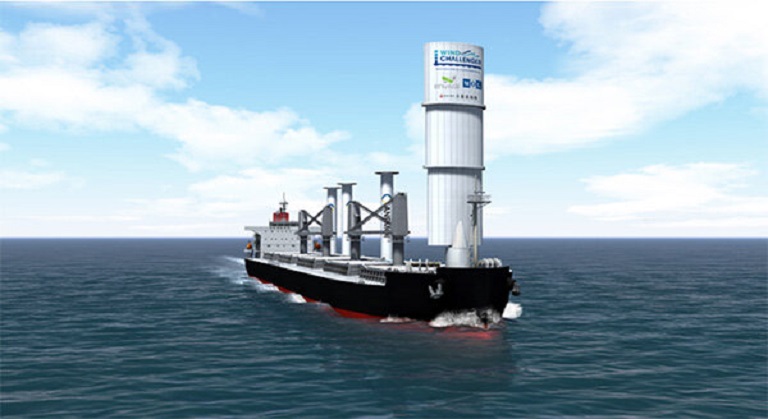Reducing Environmental Impact by Using Wind as Vessel's Propulsive Force
TOKYO-Mitsui O.S.K. Lines, Ltd. (MOL) on Wednesday (Aug10) announced its intent to equip a second bulk carrier with the "Wind Challenger" (Note 1) hard sail system, which harnesses the power of wind to propel the vessel.

MOL Group company MOL Drybulk Ltd. will operate the vessel, which will transport wood pellets for Enviva Inc. (Enviva) (Note 2), the world's leading producer of sustainable wood bioenergy, and has signed a construction contract for the new ship with Oshima Shipbuilding Co., Ltd. The vessel, slated for delivery in 2024, will be the second Wind Challenger-equipped vessel in the MOL Group fleet, following one scheduled to enter services in October of this year (Note 1).
MOL group is also examining the feasibility of adopting "Rotor Sails, (Note 3)" an auxiliary wind propulsion system developed by Anemoi Marine Technologies Ltd, of the U.K. Combined use of both the Wind Challenger and Rotor Sails is expected to reduce greenhouse gas (GHG) emissions by an average of 20%.
For years, Enviva and MOL have engaged in discussions to improve the efficiency of marine transportation through a contract for the shipping of wood pellets in Atlantic waters. In recent years, there has been a need to reduce the environmental impact of the entire supply chain. As we entered into a partnership in March 2021 with the aim of realizing an environmentally friendly bulk carrier, we have been considering the introduction of energy-saving technology and this is a culmination of our studies so far.
MOL Group clearly states that the group will make a concerted effort to achieve net zero GHG emissions by 2050, under "MOL Group Environmental Vision 2.1." It will further push forward adoption of energy-saving technologies using wind such as the Wind Challenger and Rotor Sails, to help reduce GHG emissions and realize a low- and de-carbonized society.
(Note 1) Wind Challenger
Concept video:
The Wind Challenger is a telescoping hard sail that converts wind energy to propulsive force. Installation of one Wind Challenger sail on merchant ships has the potential to significantly reduce fuel consumption, which in turn reduces GHG emissions by about 5-8%. A bulk carrier for Tohoku Electric Power Co., Inc., the first vessel equipped with the Wind Challenger, is slated to be delivered in October 2022.
(Note 2) Enviva
Enviva is the world's largest producer of industrial wood pellets, a renewable and sustainable energy source that is produced by aggregating a natural resource, wood fiber, and processing it into a transportable form, wood pellets. Enviva sells most of its wood pellets through long-term, take-or-pay off-take contracts with creditworthy customers in the United Kingdom, the European Union, and Japan, helping to accelerate the energy transition and to decarbonize hard-to-abate sectors like steel, cement, lime, chemicals, and aviation fuels.